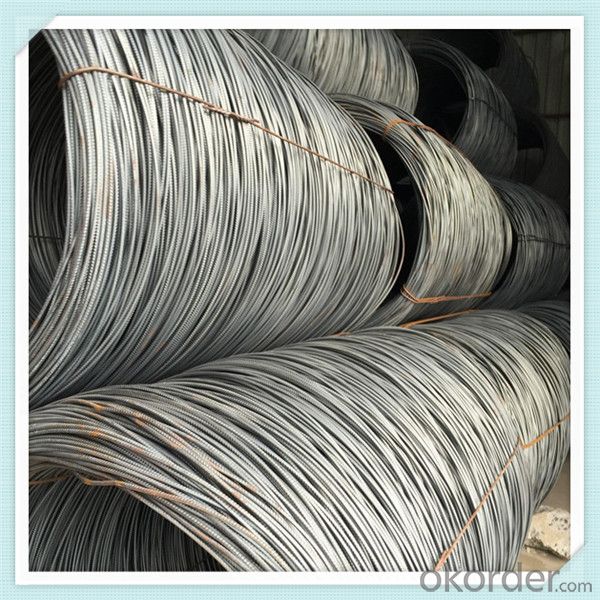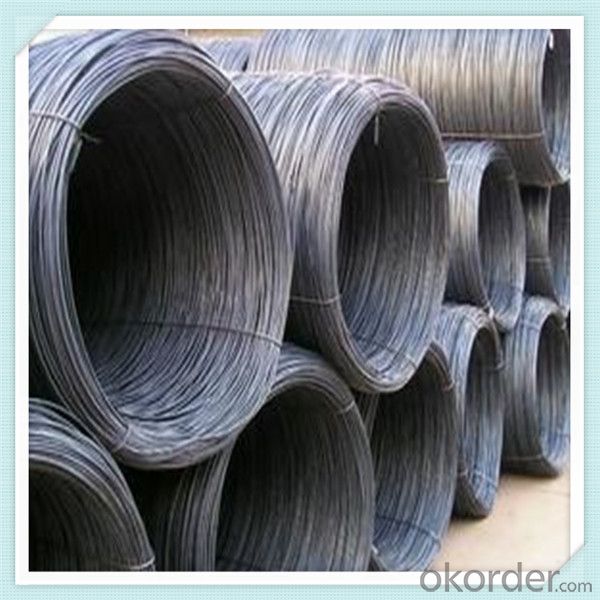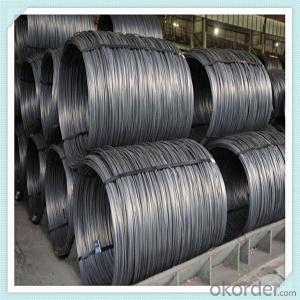HRB400 steel wire rod hot rolled in good quality
- Loading Port:
- Guangzhou
- Payment Terms:
- TT OR LC
- Min Order Qty:
- 100 m.t.
- Supply Capability:
- 14253 m.t./month
OKorder Service Pledge
OKorder Financial Service
You Might Also Like
Item specifice
Features
1、Pure steel quality, stable chemical contents, small tolerance.
2、Constant Quality, good drawing performance.
3、High dimension accuracy degree, accuracy degree of Level C up to 80%, smooth surface, less scale,
easy to be pickled.
4、Automatic bundling with 4 lines by Machine in tidy and good looks
5、Big high quality percentage, small coil percentage, and heavy coil weight for Hard Coil.
6、High sorbitizing percentage.
Used to make steel nail, mechanical spare parts. The high carbon steel wire coil is used to make steel
wire rope for different usage, spring steel wire, steel core Al strands, galvanized steel wire, galvanized steel
strands, prestressing steel wire
Mainly used in building and construction as binding wire, tie wire and baling wire; also can be make for wire mesh.
Product Description :
Standard | AISI, ASTM, BS, DIN, GB, JIS |
Material/steel grade | Q195-Q235,SAE1006B,SAE1006CR, SAE1008B, SAE1008CR, SAE1010B, SAE1018B, or according to customers requirements |
Wire Gauge | 5.5-12mm |
Coil weight | 1.8-2.1mts |
MOQ | 25MT |
Delivery Time | 15-30 days after receipt of L/C or deposit by T/T |
Packing | In coil and load in container, if large quantity, by bulk vessel; Can be packed as customers' special requirements |
Payment terms | 1).100% irrevocable L/C at sight. 2).30% T/T prepaid and the balance against the copy of B/L. 3).30% T/T prepaid and the balance against L/C |
Application | widely used in machinery parts, manufacturing industry, electronics industry, metal tools and others |


Application :
It generally used in braiding the hose for bathing product and machinery. With it
good flexibility, resistant to high temperature and resistant to corrosion, it
used widely in many industries.
Packing :
Hot-rolled wire rod is held in a unit with at least four steel straps in the
transverse direction and transported and stored without further packaging.
Before
the steel strapping is applied, the wire rod must be sufficiently compressed.
The strapping is fixed in the transverse direction with a single circumferential
strap so that the strapping does not slip and cause the coil to come apart.


Our service:
(1) We cooperate with famous factories with advanced equipment and well trained workers.
(2) We can provide factory price with trading company service.
(3) We continuously work on the improvement of our processes, guaranteeing
consistently high standards of quality to keep none compensation.
(4) We guarantee 24 hours response and 48 hours solution providing service.
(5) We accept small order quantity before formal cooperation.
(6) We deliver the agreed quality at the agreed time, reacting to changes in
customer wishes in a flexible way.
(7) Due to our volume and selling power, we have excellent freight rates with
shipping lines.
(8) We strive to always be fair and honest in our dealings with customers.
(9) We strive to work together with customers to achieve much more than we can
achieve alone.
(10) Through our passion and commitment we aim to be a market leader in all our
key markets. To maintain our position as market leader we must continue to add
value in all that we do.
FAQ:
1.Q: What's your MOQ(minimum order quantity)?
A: One full container, mixed acceptable .
2. Q: What's your packing methods?
A: Packed in bundle or bulk ..
3. Q: How can I buy CNBM products in my country?
A:Please send us an inquiry or email ,we will reply to you if there is distributor in your country
4. Q: Can we visit your factory?
A: Warmly welcome. Once we have your schedule, we will arrange the
professional sales team to follow up your case.
5. Q: How long does it take to get the product if i place an order?
A:With the process of your requirements,we will pack and deliver in 3
-7 days. If it is by sea shipment,it will take 15-45 days depending on different locations
- Q:What are the different types of heat treatment processes for steel wire rod?
- Steel wire rod can undergo various heat treatment processes, each with its own advantages and effects on the material. 1. Annealing: By heating the steel wire rod to a specific temperature and slowly cooling it, annealing improves the material's ductility and toughness. This makes it easier to shape and form. 2. Quenching and tempering: The steel wire rod is heated to a high temperature and then rapidly cooled, or quenched, to increase its hardness and strength. It is then tempered by reheating it to a lower temperature to reduce brittleness and enhance toughness. 3. Normalizing: Similar to annealing, normalizing involves heating the steel wire rod to a specific temperature and cooling it in still air. This process refines the grain structure, enhancing strength and machinability. 4. Stress relieving: By heating the steel wire rod to a specific temperature and slowly cooling it, stress relieving reduces internal stresses caused by previous manufacturing processes. This improves dimensional stability and minimizes the risk of distortion during subsequent processing or use. 5. Case hardening: Also known as carburizing, this process introduces carbon into the surface layer of the steel wire rod to increase its hardness. It is achieved by heating the wire rod in a carbon-rich atmosphere. Case hardening creates a hard outer layer while maintaining a softer and more ductile core, providing a combination of wear resistance and toughness. Each heat treatment process can be customized to achieve specific material properties for the desired application. Factors such as desired hardness, strength, toughness, and machinability influence the choice of process for the steel wire rod.
- Q:What are the common production processes for xenon-coated steel wire rod?
- The common production processes for xenon-coated steel wire rod typically involve cleaning and pre-treating the steel wire rod, followed by applying a xenon coating using various methods such as physical vapor deposition or chemical vapor deposition. The coated wire rod is then subjected to curing or annealing processes to enhance the adhesion and durability of the xenon coating. Finally, the wire rod is further processed into desired shapes or sizes for specific applications.
- Q:What are the different surface treatments for steel wire rod?
- Some of the different surface treatments for steel wire rod include galvanizing, phosphating, and coating with a polymer or plastic material.
- Q:What are the common warranty considerations for steel wire rod?
- There are several common warranty considerations for steel wire rod, including the durability and strength of the material, compliance with industry standards and specifications, and the absence of defects such as surface imperfections or dimensional inaccuracies. Additionally, warranties often cover the performance of the wire rod in specific applications, such as its ability to withstand corrosion or maintain its structural integrity over time.
- Q:How is steel wire rod used in the manufacturing of wire mesh fencing?
- Steel wire rod is used in the manufacturing of wire mesh fencing as it serves as the primary raw material. The wire rod is first drawn into the desired thickness and then woven or welded to create the wire mesh. The strong and durable nature of steel wire rod ensures that the resulting wire mesh fencing is capable of withstanding external forces and providing security and containment in various applications.
- Q:What are the main factors influencing the choice of steel wire rod storage conditions?
- The choice of storage conditions for steel wire rods is influenced by several primary factors. These factors encompass the type and quality of the rods, their intended use or application, environmental conditions, and safety considerations. To begin with, the storage conditions are significantly determined by the type and quality of the steel wire rods. Specific requirements for temperature, humidity, and exposure to elements may exist for different types of rods. For example, corrosion-resistant rods may necessitate controlled humidity levels to prevent rusting, while high carbon rods may require specific temperature conditions to maintain their mechanical properties. Another crucial factor is the intended use or application of the steel wire rods. Industries like aerospace or automotive, which demand stringent storage conditions to preserve the desired properties of the rods, may utilize certain wire rods. Conversely, if the rods are intended for general use or non-critical applications, the storage conditions may be more flexible. Environmental conditions also impact the choice of storage conditions. Factors such as temperature, humidity, and sunlight exposure can affect the quality and durability of the rods. Extreme heat or cold can cause expansion or contraction, potentially leading to deformation or breakage. High humidity levels can promote corrosion, while excessive sunlight exposure can result in discoloration or degradation of the rods. Lastly, safety considerations play a vital role in determining the storage conditions for steel wire rods. Proper storage arrangements may be required for hazardous or flammable rods to ensure the safety of personnel and the surrounding environment. Additionally, it is important to consider proper handling and storage practices, such as securing the rods to prevent accidental falls or collisions, in order to avoid damage or injury. In conclusion, the choice of storage conditions for steel wire rods is influenced by factors such as the type and quality of the rods, their intended use, environmental conditions, and safety considerations. By considering these factors, one can ensure optimal storage conditions for steel wire rods, preserving their quality and ensuring their suitability for the intended applications.
- Q:What are the main factors influencing the choice of steel wire rod order packaging marking options?
- The main factors influencing the choice of steel wire rod order packaging marking options include compliance with industry standards, customer requirements, and logistical considerations. Firstly, compliance with industry standards is a critical factor in choosing the packaging marking options for steel wire rod orders. Different industries may have specific requirements for the type and placement of markings on packaging materials. These standards ensure that the product can be easily identified, tracked, and handled throughout the supply chain. Compliance with these standards is essential for smooth operations and to meet regulatory requirements. Secondly, customer requirements play a significant role in determining the packaging marking options. Customers may have specific labeling or marking requirements that need to be followed. These requirements can vary based on the destination of the product, customer preferences, and any specific branding or identification needs. Meeting customer requirements is crucial for customer satisfaction and maintaining strong business relationships. Lastly, logistical considerations also influence the choice of packaging marking options. The way the steel wire rod orders are handled during transportation, storage, and loading/unloading can impact the choice of packaging markings. For example, if the orders are frequently stacked or stored in specific orientations, the markings need to be placed accordingly to ensure easy identification and handling. Additionally, considering the size, shape, and material of the packaging itself is important to determine the most suitable marking options. Overall, the main factors influencing the choice of steel wire rod order packaging marking options are industry standards, customer requirements, and logistical considerations. By carefully considering these factors, businesses can ensure efficient and effective packaging marking solutions that meet the needs of all stakeholders involved.
- Q:What are the safety considerations when working with steel wire rod?
- Some safety considerations when working with steel wire rod include wearing appropriate personal protective equipment (PPE) such as gloves, safety glasses, and steel-toed boots to protect against cuts, eye injuries, and foot injuries. It is important to handle the wire rod with caution to prevent it from unraveling or causing puncture injuries. Proper training on the use of tools and machinery involved in the handling and cutting of steel wire rod is essential to prevent accidents. It is also crucial to maintain a clean and organized work area to minimize tripping hazards and to ensure proper storage of the wire rod to prevent it from becoming a safety hazard.
- Q:How is steel wire rod used in the manufacturing of wire for electrical applications?
- Steel wire rod is a crucial component in the manufacturing of wire for electrical applications. It serves as the primary raw material that undergoes various processes to transform into the final wire product. To begin with, steel wire rod is typically made from carbon or alloy steel, which possesses excellent strength and durability properties. The rod is usually produced in large coils or bundles, allowing for efficient transportation and handling during the manufacturing process. The first step in using steel wire rod for electrical wire manufacturing is the process of drawing. During this process, the rod is passed through a series of dies that gradually reduce its diameter. This drawing process helps to refine the steel's structure, align its grain boundaries, and enhance its mechanical properties such as tensile strength and ductility. Once the desired diameter is achieved, the drawn wire is further processed to improve its conductivity for electrical applications. This is typically done through a process called annealing, where the wire is heated and then slowly cooled. Annealing helps to relieve any internal stress or strain in the wire, making it more flexible and conductive. After annealing, the wire may undergo additional surface treatments such as coating or plating to enhance its corrosion resistance or provide specific electrical properties. These treatments can include the application of various metals or insulating materials, depending on the specific requirements of the electrical application. Finally, the wire is spooled or coiled into specific lengths and packaged for distribution to various industries that utilize electrical wire. These industries can range from power generation and distribution, telecommunications, automotive, electronics, and many others. In summary, steel wire rod is an essential material in the manufacturing of wire for electrical applications. It undergoes processes such as drawing, annealing, and surface treatments to transform it into a high-quality wire with excellent mechanical and electrical properties. The end result is a versatile product that can be used in a wide range of electrical applications, ensuring the efficient and reliable transmission of electricity.
- Q:How is steel wire rod used in the manufacturing of wire forms for industrial filters?
- Steel wire rod is a crucial component in the manufacturing process of wire forms for industrial filters. The wire rod is first subjected to a series of mechanical and chemical processes to ensure its durability and strength. Once it meets the required specifications, it is then transformed into various wire forms that are used in the construction of industrial filters. One of the primary uses of steel wire rod in manufacturing wire forms for industrial filters is to create the support structure. The wire rod is typically bent, twisted, or welded to form a sturdy framework that holds the filter together. This support structure ensures that the filter is able to withstand the pressure and stress it will encounter during its operation. Additionally, steel wire rod is used to create the filtering elements within the industrial filters. These filtering elements are often made by weaving, knitting, or welding the wire rod into a mesh or screen-like structure. This allows the filter to efficiently trap and remove unwanted particles or contaminants from various fluids or gases. The strength and durability of steel wire rod make it an ideal material for manufacturing wire forms for industrial filters. It can withstand high temperatures, corrosive environments, and heavy loads, ensuring that the filter remains functional and reliable in challenging industrial settings. Furthermore, steel wire rod can be easily manipulated and customized to meet specific requirements. Different diameters, tensile strengths, and surface finishes can be achieved by selecting the appropriate steel grade and applying specific manufacturing techniques. This versatility allows manufacturers to create wire forms that are tailored to the specific needs of different industrial applications. In conclusion, steel wire rod plays a vital role in the manufacturing of wire forms for industrial filters. Its strength, durability, and versatility make it an essential material for creating the support structures and filtering elements that are necessary for the proper functioning of these filters.
1. Manufacturer Overview |
|
|---|---|
| Location | |
| Year Established | |
| Annual Output Value | |
| Main Markets | |
| Company Certifications | |
2. Manufacturer Certificates |
|
|---|---|
| a) Certification Name | |
| Range | |
| Reference | |
| Validity Period | |
3. Manufacturer Capability |
|
|---|---|
| a)Trade Capacity | |
| Nearest Port | |
| Export Percentage | |
| No.of Employees in Trade Department | |
| Language Spoken: | |
| b)Factory Information | |
| Factory Size: | |
| No. of Production Lines | |
| Contract Manufacturing | |
| Product Price Range | |
Send your message to us
HRB400 steel wire rod hot rolled in good quality
- Loading Port:
- Guangzhou
- Payment Terms:
- TT OR LC
- Min Order Qty:
- 100 m.t.
- Supply Capability:
- 14253 m.t./month
OKorder Service Pledge
OKorder Financial Service
Similar products
New products
Hot products
Related keywords


























